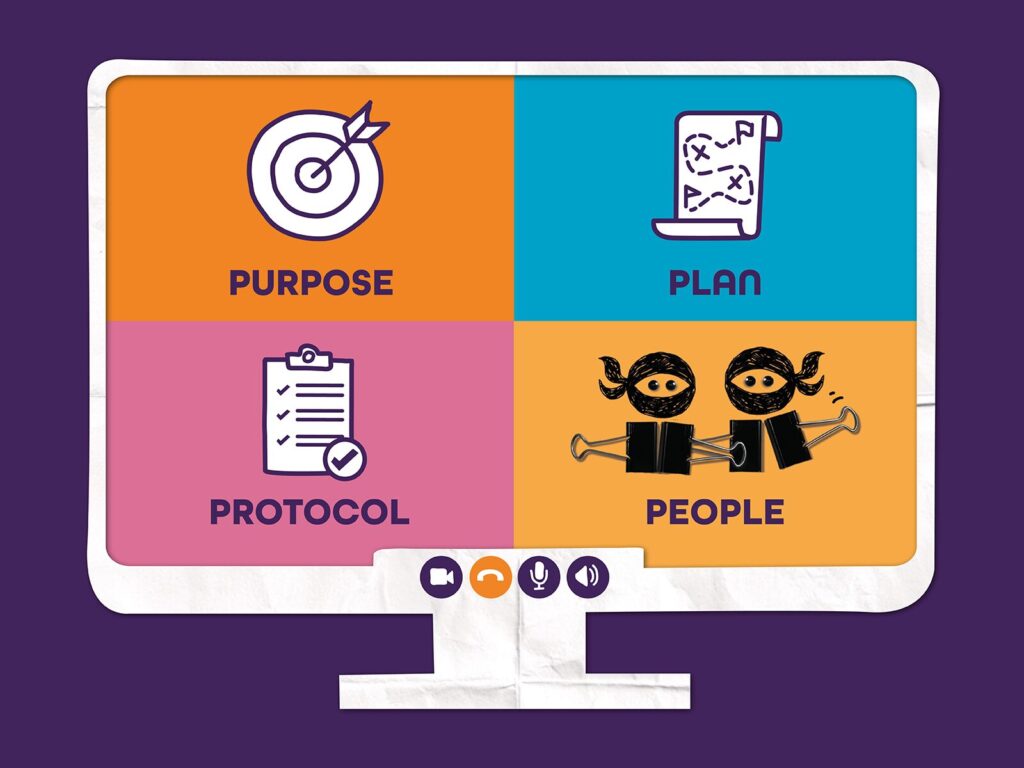The 4 P’s turn meeting frustration into productive momentum.
The Productivity Killer
Virtual meetings are killing our productivity. As the number of meetings in the digital office has skyrocketed, our productivity has nosedived – an inevitable byproduct of hopping from one Microsoft Teams, Zoom, or Google meet to another.
For the past 3 years, our clients throughout Europe and the Middle East have been sharing the same problem:
‘I spend all my day in meetings, I don’t have time to do the work.’
Meeting Overload
Digital meetings pose a challenge. The opportunity to easily brainstorm, discuss, align, and decide across teams, departments, and offices has become the new default – the the point where we’re overloading ourselves and others.
What used to be quick 5-minute conversations have morphed into virtual meetings in our calendars. And these meetings rarely last less than 30 minutes when 5-10 minutes would suffice.
When my colleague Heike recently reviewed the calendars of a workshop group, she found that participants were meeting on average for 8(!) hours a day.
And while meeting quantity has been rising…
… meeting quality has been sinking
When we ask clients to describe their thoughts on meetings, top answers include:
- Unproductive
- Long
- Too many
- Unfocused
Sound familiar? As we have little time outside virtual meetings, we’re increasingly using that time to perform other tasks, all while the meeting content passes us by.
Being in a meeting doesn’t necessarily mean we are connected. When we are not, meeting quality suffers – and the meeting feels like an exhausting waste of time.
Fortunately, it doesn’t have to be this way. Whether you’re the chair or the participant, the 4 P’s will supercharge any virtual meeting and turn frustration into productive momentum.
The 4 P’s for Productive Meetings
Your virtual meeting starts long before you log on. In our experience, meeting productivity is a direct function of meeting preparation.
The more you plan and prepare for a meeting, the more you will attain your goals from the discussion and help bring the conversation to a meaningful conclusion.
The 4 P’s offer an effective guide for just that:
- Purpose
- Plan
- Protocol
- People

Purpose
If it’s your meeting, develop and clearly state the purpose. Outline what you will achieve by the end of the meeting: ‘By the end of this virtual meet we will…. (insert your own bullet points).’
Conversely, if it’s someone else’s meeting, you can message them beforehand: ‘I’m planning for the meeting next week. It would be really helpful to know what you want to achieve by the end of the conversation.’ And for an added bonus you could also ask, ‘Is there anything you specifically need from me?’
Plan
Your plan is your agenda. Rather than just a list of headings, be clear on the objective for each item, how long it will take, who is leading, and what planning and prep is needed.
And remember: We don’t want to use meetings to share information and update people. We want the meeting to be a discussion about the updates, the identification of actions, and an opportunity for people to be creative.
Protocol
Establish a few simple but effective protocols and double check that they are in place before sending your meeting invite:
- Joining instructions. Let people know what will be expected of them during the session. And don’t forget the meeting link!
- Logging in time. At Think Productive WESA we have the habit of starting virtual meetings four minutes after the log-in time. That way, participants can take a breath and focus before we start. And latecomers don’t interrupt the meeting flow.
- Contribution. Let others know if you prefer them to contribute on voice, using the chat, or via the Q&A function.
People
In every ‘Fixing Meetings’ workshop we do, participants tell us how they are invited to meetings they know little about. Or on the flip side, how they feel they must invite everyone.
Though it’s a thin line, we ideally want as few people as possible to actually make decisions. At the same time, we need everyone who has something relevant to offer.
Don’t be afraid to ask if you are an essential attendee. And if there is something specific the organizer would like you to contribute.
If you are the organizer, include in the invite a sentence on why you are inviting each person. That makes it much clearer, and therefore more likely, that the right people will attend – and are being prepared.
Less is more
Doing the 4 P’s right will supercharge your virtual meetings. But preparation requires time. In order to add time to our calendars, we need to start saying ‘no’ to meetings where the 4 P’s are not spelled out or where our contribution is simply not required.
We discuss the best ways to say ‘no’ to meeting invites in our workshop and Hayley’s book ‘How to Fix Meetings’.


